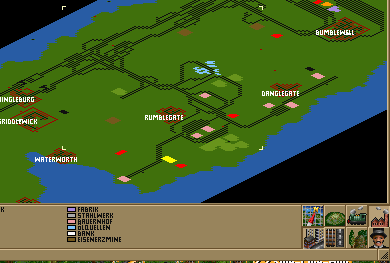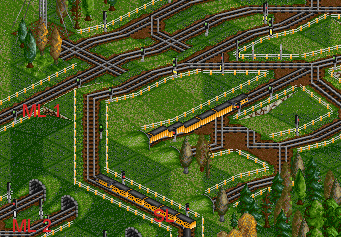Difference between revisions of "Tutorial Savegame Sideline"
From #openttdcoop wiki
m |
(Clarity and grammar edits, and some content expansion) |
||
| Line 6: | Line 6: | ||
==2.1 Sideline where needed== | ==2.1 Sideline where needed== | ||
[[Image:Tutorial Savegame 2.1.png|390px|frame|left]] | [[Image:Tutorial Savegame 2.1.png|390px|frame|left]] | ||
| − | Try to minimize the number of [[Sideline|Sidelines]] by placing them properly on the map. The industry-view mode of your map helps you | + | Try to minimize the number of [[Sideline|Sidelines]] by placing them properly on the map. The industry-view mode of your map helps you spot the right places for building [[Sideline Hub|Sideline Hubs]]. If you have the opinion that one industry is too far off an existing sideline, start a new one! If you plan properly, however, you can minimize the number of Sidelines needed, therefore reducing the construction work (and possibilities for congestion) in a game. |
<br style="clear: both;" /> | <br style="clear: both;" /> | ||
| − | ==2.2 | + | ==2.2 Sideline-Hub== |
| − | At this sign you see a rather common implementation of a [[Sideline Hub]]. | + | At this sign you see a rather common implementation of a [[Sideline Hub]]. Terrain and track layout determine the exact shape of a sideline hub. Each sideline hub will typically be slightly different—there are a lot of correct ways (as well as incorrect ways) to build a sideline hub. |
| − | ==2.3 Sideline Exit | + | ==2.3 Sideline Exit Load Balancer== |
[[Image:Tutorial Savegame 2.3.png|341px|frame|left]] | [[Image:Tutorial Savegame 2.3.png|341px|frame|left]] | ||
| − | An Exit | + | An Exit Load Balancer is needed whenever a sideline track leads into a [[Mainline]]. It is assumed that a Mainline is a well-used part of your network with at least two tracks in one direction. Due to the common pathfinder in OTTD, a train - roughly spoken - chooses the shortest path to its destination. Therefore, a second rail into the same direction could easily become obsolete if trains only choose the closer one. They even try to access the closer rail if this rail is already occupied by another train moving on the Mainline. It is obvious that we need some kind of solution to this problem. |
| − | The first thing you should be able to deal with are [[Presignals]]. Look at the dedicated [[Guides]] if you are yet not aware of their functionality. A dedicated Guide about | + | The first thing you should be able to deal with are [[Presignals]]. Look at the dedicated [[Guides]] if you are yet not aware of their functionality. A dedicated Guide about load balancers in general can be found in the [[Guides:Load_Balancers|load balancers guide]]. The good thing and main reason for the Tutorial you're reading is that you are able to see an exit load balancer in action! |
If you look at the picture to the left you see the Mainline going from the west to the east, having two tracks (ML 1 and ML 2). One Sideline Track (SL) offers access to both mainline tracks. The signaling is constructed in order to let the train on the Sideline "look ahead" and choose - if available - a free track. Now there are two advantages: on the one hand the Mainline is used more efficiently; gaps on the tracks may be filled with trains approaching via the Sideline. On the other hand, the Sideline trains are more likely to maintain full speed due this "look ahead" feature of the Loadbalancer. Note that the construction secures trains moving on the Mainline the full speed in any situation. | If you look at the picture to the left you see the Mainline going from the west to the east, having two tracks (ML 1 and ML 2). One Sideline Track (SL) offers access to both mainline tracks. The signaling is constructed in order to let the train on the Sideline "look ahead" and choose - if available - a free track. Now there are two advantages: on the one hand the Mainline is used more efficiently; gaps on the tracks may be filled with trains approaching via the Sideline. On the other hand, the Sideline trains are more likely to maintain full speed due this "look ahead" feature of the Loadbalancer. Note that the construction secures trains moving on the Mainline the full speed in any situation. | ||
Revision as of 03:06, 18 July 2007
2.0 Sideline
This section belongs to Sideline related tips and tricks.
2.1 Sideline where needed
Try to minimize the number of Sidelines by placing them properly on the map. The industry-view mode of your map helps you spot the right places for building Sideline Hubs. If you have the opinion that one industry is too far off an existing sideline, start a new one! If you plan properly, however, you can minimize the number of Sidelines needed, therefore reducing the construction work (and possibilities for congestion) in a game.
2.2 Sideline-Hub
At this sign you see a rather common implementation of a Sideline Hub. Terrain and track layout determine the exact shape of a sideline hub. Each sideline hub will typically be slightly different—there are a lot of correct ways (as well as incorrect ways) to build a sideline hub.
2.3 Sideline Exit Load Balancer
An Exit Load Balancer is needed whenever a sideline track leads into a Mainline. It is assumed that a Mainline is a well-used part of your network with at least two tracks in one direction. Due to the common pathfinder in OTTD, a train - roughly spoken - chooses the shortest path to its destination. Therefore, a second rail into the same direction could easily become obsolete if trains only choose the closer one. They even try to access the closer rail if this rail is already occupied by another train moving on the Mainline. It is obvious that we need some kind of solution to this problem.
The first thing you should be able to deal with are Presignals. Look at the dedicated Guides if you are yet not aware of their functionality. A dedicated Guide about load balancers in general can be found in the load balancers guide. The good thing and main reason for the Tutorial you're reading is that you are able to see an exit load balancer in action!
If you look at the picture to the left you see the Mainline going from the west to the east, having two tracks (ML 1 and ML 2). One Sideline Track (SL) offers access to both mainline tracks. The signaling is constructed in order to let the train on the Sideline "look ahead" and choose - if available - a free track. Now there are two advantages: on the one hand the Mainline is used more efficiently; gaps on the tracks may be filled with trains approaching via the Sideline. On the other hand, the Sideline trains are more likely to maintain full speed due this "look ahead" feature of the Loadbalancer. Note that the construction secures trains moving on the Mainline the full speed in any situation.

